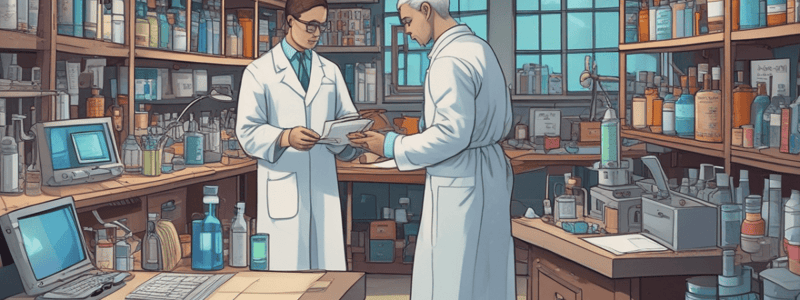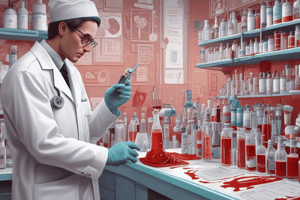Podcast
Questions and Answers
What is a characteristic of Arterial Puncture?
What is a characteristic of Arterial Puncture?
- Safer
- Larger amount of blood
- Higher risk (correct)
- Less invasive
What is an advantage of POCT?
What is an advantage of POCT?
- Requires specialized training
- Is safer (correct)
- Requires a larger amount of blood
- Is more invasive
What type of needle is used in the Vacutainer Method?
What type of needle is used in the Vacutainer Method?
- Double-sided needle (correct)
- Slip Tip
- Luer Lock
- Single-sided needle
What is an advantage of the Syringe Method?
What is an advantage of the Syringe Method?
What type of sample is typically analyzed using Urinalysis?
What type of sample is typically analyzed using Urinalysis?
What is a type of sample that may be analyzed using Cytology?
What is a type of sample that may be analyzed using Cytology?
What is the purpose of using 10% Formalin in Histology?
What is the purpose of using 10% Formalin in Histology?
What is a consideration when selecting a needle length for a Syringe Method?
What is a consideration when selecting a needle length for a Syringe Method?
What is the color of the blood tube used for collecting blood samples for glucose tests?
What is the color of the blood tube used for collecting blood samples for glucose tests?
Which of the following tests is not performed on a blue top blood tube?
Which of the following tests is not performed on a blue top blood tube?
What is the purpose of the anticoagulant in a purple top blood tube?
What is the purpose of the anticoagulant in a purple top blood tube?
Which department is responsible for performing lipid profile tests?
Which department is responsible for performing lipid profile tests?
What is the purpose of the green top blood tube?
What is the purpose of the green top blood tube?
Which of the following tests is not performed on a red or yellow top blood tube?
Which of the following tests is not performed on a red or yellow top blood tube?
What is the purpose of sodium citrate in a blue top blood tube?
What is the purpose of sodium citrate in a blue top blood tube?
Which department is responsible for performing HIV tests?
Which department is responsible for performing HIV tests?
What is the purpose of EDTA in a purple top blood tube?
What is the purpose of EDTA in a purple top blood tube?
Which of the following tests is performed on a green top blood tube?
Which of the following tests is performed on a green top blood tube?
Flashcards are hidden until you start studying
Study Notes
Laboratory Samples
- Laboratory samples can be classified into two categories: blood and non-blood samples.
- Blood samples can be further divided into arterial, venipuncture, and capillary samples.
Blood Collection Methods
- Syringe method: uses a slip tip or luer lock syringe, available in various capacities (3, 5, 10, 20, 60 cc), and needles with different gauges and lengths.
- Vacutainer method: uses a double-sided needle and a vacuum-dependent system.
Blood Tubes
- Anticoagulated blood tubes: used for plasma samples, available in different colors, each with specific anticoagulants and additives.
- Gray top: contains sodium fluoride and potassium oxalate, used for glucose tests.
- Purple top: contains EDTA, used for CBC, ESR, and sickle cell tests.
- Blue top: contains sodium citrate, used for PT, PTT, and INR tests.
- Green top: contains lithium heparin, used for chemistry tests.
- Non-anticoagulated blood tubes: used for serum samples, available in red or yellow (SST) tubes.
- Red or yellow top: used for lipid profile, renal function, liver function, and other tests.
Common Tests and Departments
- Clinical Chemistry: glucose, lipid profile, renal function, liver function, and other tests.
- Hematology: CBC, ESR, sickle cell test, and blood type.
- Coagulation/Hematology/Clinical Chemistry: PT, PTT, INR, D-DIMER tests.
- Immunology: ELISA, CLIA, microbead, and IF tests for various analytes.
Non-Blood Samples
- Urine: used for urinalysis, 24-hour urine analysis, and microscopy.
- Stool: used for microscopy, analysis, and count.
- Sputum: used for analysis and count.
- Semen: used for analysis and count.
- Swabs: used for throat, wound, and rectal swab analysis.
- Fluids: used for synovial, pleural, CSF, and other fluid analysis.
- Cytology: used for histology and cytology tests.
- Histology: used for tissue analysis, typically with 10% formalin.
Studying That Suits You
Use AI to generate personalized quizzes and flashcards to suit your learning preferences.




